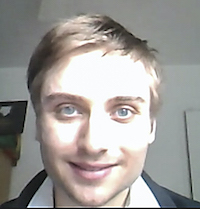
David Abramovitch
University of California, Bekeley
Simulating Runaway Electron Formation During the Thermal Quench in Tokamaks
David Abramovitch, Chang Liu, and Dylan Brennan
Runaway Electrons (REs) are a great concern in tokamak plasmas, particularly in ITER due to the potential for highly energetic runaways due to large current. The runaway dynamics are heavily influenced by the initial generation of runaways immediately after the disruption, the runaway seed. The complex dynamics of the inductive electric field and electron-electron collisions, including small angle collisions, are typically not included in analytic predictions, nor in previous numerical techniques relying on the linear collision operator. Here we simulate REs using the NORSE (Non-linear Relativistic Solver for Electrons) code, which treats collisions in the plasma relativistically and non-linearly and calculates the electric field inductively. We calculate runaway electron seed generation under varying initial temperatures and thermal quench rates for ITER like conditions. Our preliminary calculations indicate that on short timescales the amount of RE seed formed during fast thermal quenches may be only a small fraction of the current, and that this fraction decreases quickly with lower temperatures and slower quenches.
Poster
Arjun Agarwal
University of Maryland
GPU-Accelerated kinetic modeling of transport in a Hall thruster channel
Arjun Agarwal, Andrew Powis, Stephane Ethier
The causes of anomalous electron transport across the magnetic barrier in Hall thrusters is an area of ongoing research. An understanding of the mechanisms causing this transport would allow for the development of turbulence models for this process. Since the transport is kinetic, the 5D particle-in-cell code LTP-PIC serves as a fitting numerical tool to carry out this study. LTP-PIC is tested with varying computational resources and physical inputs. The code is shown to have functional weak scaling but poor strong scaling behavior. Variations of the ionization rate and the magnetic field yield physical trends. Given that PIC codes are computationally expensive, requiring a large number of particles and time steps, adapting this MPI + OpenMP portable code to GPU using the OpenACC standard decreases runtime while maintaining a single code base.
Poster
Ben Antognetti
University of New Hampshire
Building a Fokker-Planck Solver using the MFEM Finite Element Library
Ben Antognetti, Syun’ichi Shiraiwa, Nicola Bertelli
Driving toroidal currents by auxiliary power is necessary for magnetic confinement in tokamaks. The process of driving these currents by radio frequency (RF) waves and the corresponding evolu- tion of the electron velocity distribution function is described as a diffusion by the Fokker-Planck (FP) equation. An efficient FP solver fully utilizing emerging computing architecture is desired for modeling the evolution of tokamak discharge. In this work, we show a new FP solver based on MFEM (www.mfem.org) finite element method library developed at Lawrence Livermore National Laboratory. Initial results on RF waves in the lower hybrid wave frequency regime will be dis- cussed. Output of this solver is compared with the results of existing code. Initial results of running the solver on a GPU architecture show that there may be some promise for the method for larger problem sizes.
Poster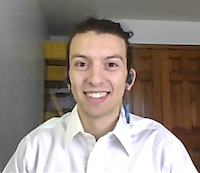
Brennan Arnold
Macalester College
Virtual prototyping of a liquid lithium divertor concept
Brennan Arnold, A. Khodak
A tokamak divertor must handle heat loads in excess of 10MW/m2 in steady states and much higher in disruptions, enough to melt nearly any material. In order to handle this extreme heat, there is some interest in using liquid metal flows to continually renew the divertor surface. In this paper, we examine an idea for a divertor with a porous surface that allows liquid lithium flowing through a channel just below the surface to percolate to the plasma facing surface. This idea is complicated by magnetohydrodynamic drag, which is an effect whereby the stong magnetic fields in the tokamak cause the lithium to flow too slowly to carry away all the heat. In order to speed the lithium up, we apply an electric current across the channel. We simulate the system using a simplified model in ANSYS, which we validate through comparisons to several analytical results. The simulation shows that the design can, in principle, handle the heat imposed on a divertor. We examine the amount of current that must be applied ot achieve sufficient lithium velocities, and begin to probe the effect of different geometries on divertor efficiency by running the simulation with different channel aspect ratios.
Poster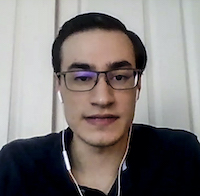
Ethan Bair
Cornell University
Two Fluid, Ten Moment Simulations of the Firehose Instability in the Solar Wind
Ethan Bair, Jason TenBarge, Jimmy Juno, Ammar Hakim
DThe solar wind is a stream of plasma that continuously flows from the sun and expands outward into the heliosphere. This expansion leads to anisotropy in pres- sure and temperature along and across magnetic fields lines that drive instabilities, such as the proton and electron firehose, mirror, and whistler instabilities. Here we explore these instabilities using the two fluid, ten moment model in the Gkeyll simulation framework. We attempt to expand upon hybrid fluid models that have been used to study these instabilities by retaining more dynamical information about the electrons, i.e., the full electron pressure tensor, while also exploring the limits of the ten-moment model to capture the physics of these kinetic instabilities. Using extended fluid models which capture these dynamically important instabili- ties provides a promising path forward for global modeling given the computational constraints inherent to kinetic modeling.
Poster
John L. Ball
University of Maryland, College Park
Implementing Optimization for Quasisymmetry on Surfaces Away from the Magnetic Axis in PyPlasmaOpt
John L. Ball, Stuart Hudson
PyPlasmaOpt is a new stellarator optimization tool under development as part of the Simons Foundation Collaboration on Hidden Symmetries and Fusion Energy, which takes a unique approach to the stellarator optimization problem by simultaneously optimizing over the magnetic field and coil degrees of freedom. This approach seeks to improve under- standing about what factors lead to complex or high tolerance coils, and help find stellarator configurations which have both desirable physics and feasible engineering. This project focused on the implementation of code to enforce qua- sisymmetry, a hidden symmetry of magnetic field magnitude on a toroidal flux surface which leads to excellent single particle confinementon that surface. The computation is based upon a near axis expansion developed by Landreman et. al.1 in 2019, which allows quasisymmetric fields to be calculated very quickly. This enforcement dramatically improves the quality of the stellarator field generated by PyPlasmaOpt.
Poster
Jason Chadwick
Carnegie Mellon University
Real-time machine learning modeling of density and pressure profiles on NSTX and NSTX-U
J. Chadwick, M.D. Boyer
Accurate real-time fusion plasma modeling is critical to implementing reliable control systems in present-day and future tokamak reactors. Physics-based approaches such as TRANSP can accurately model profile evolution of toka- mak plasmas, yet are too computationally intensive for use in real-time controls. To address this, a machine learning based approach to modeling density and temperature profiles has been developed and tested on the NSTX experimental database. The model predicts the shape of the electron density and temperature profiles based on scalar quantities that can be measured and/or predicted in real-time, e.g, plasma boundary shaping and plasma current. This approach is or- ders of magnitude faster than comparable TRANSP predictions and shows potential for use in optimization algorithms. Different neural network architecture designs are evaluated for accuracy and the number of samples required for model convergence is determined. Challenges in predicting scenarios beyond the training space, such as predicting future shots based on past data, are discussed and potential solutions are tested.
Poster
Amelia Chambliss
Reed College
Shape gradients and tolerances of permanent magnets for MUSE stellarator
Amelia Chambliss, Caoxiang Zhu
Calculating stellarator tolerance of permanent magnet position is an important stage in stellarator design, since the plasma is highly sensitive to small field perturbations. Common approaches to calculating tolerances include the brute- force scan, the shape gradient, and the Hessian matrix. In this paper, we used the shape gradient method to calculate the sensitivity of normal field error to dipole position for a two-period rotating elliptical stellarator and an NCSX-like candidate field for the MUSE stellarator, both of which use permanent magnets to construct the field. The magnitude of the vector of shape gradient values for dipole position in the rotating ellipse case were between 4.3 × 10−12 and 7.7×10−7T2m and the shape gradient for the NCSX variation stellarator were between 2.8×10−9 and 5.0×10−7T2m. We calculated dipole position tolerances of normal field error, and found that the shape gradient does not provide a complete picture of system sensitivity. We found that a calculation of the Hessian matrix is necessary in the case of normal field error to obtain more accurate sensitivity metrics.
Poster
Nigel DaSilva
Rensselaer Polytechnic Institute
Testing H-mode pedestal transport models through predictive simulations
Nigel DaSilva, Walter Guttenfelder
A number of theoretical transport and stability mechanisms are predicted to impact the structure of the tokamak pedestal – the boundary region with steep temperature and density gradients that provide good energy confinement. While collisional diffusion provides a minimum for transport, various turbulent mechanisms and MHD instabilities limit the total temperature, density, and pressure gradients by allowing relatively efficient particle and energy transport. We are particularly interested in these microinstabilities since unraveling their role in setting these gradients remains a key research area for predicting fusion performance. This project focused on predicting temperature and density gradients in the pedestal through modeling multiple transport mechanisms to test if they can adequately explain experimental observations. This was accomplished by numerically solving several coupled, time-dependent transport equations using simplified transport models based on first-principles simulations. A simplified toy model coded in python successfully reproduced several known turbulent effects regarding the behavior of neoclassical diffusion and electron temperature gradient transport, as well as the temperature diffusivity being clamped by kinetic ballooning modes. A more realistic predictive simulation was then developed, whose predicted temperature/density gradients were compared to experimental data from NSTX-U tokamak discharges. Unfortunately due to time constraints, the model was only able to predict that neoclassical transport alone overestimated electron density profiles, which is supported by theoretical models.
Poster
Alexis Demirjian
Barnard Collegey
Spectral Emission Data Processing
Alexis Demirjian, Shurik Yatom
Analysis of spectral emission from plasmas is a versatile tool for diagnostics of various plasma parame- ters and chemical reactivity induced by plasma in the gas. In low-temperature plasmas the analysis of the broadband spectra becomes complex and time-consuming, due to involvement of multiple species, i.e. ions, neutrals and molecules in gas mixtures. To alleviate the complexity of analysis we seek to establish framework for automatic analysis of broadband spectra. Current project is focused on algorithm that finds spectral lines in the spectrum. To this end we have attempted several approaches on algorithmic detection and filtering of the spectra, in order to clear the spectra, eliminate noise, background and determine intensities. Preliminary results show that algorithm based on the percentile filter has high potential for such an analysis.
Poster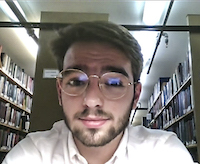
Sean M. Donnelly
Iowa State University
Numerical steepest descent algorithm for metaplectic geometrical optics
Sean M. Donnelly, Nicolas A. Lopez, and I. Y. Dodin
Radiofrequency waves are widely used for auxiliary heating and current drive in fusion plasmas. The design and optimization of such systems is often performed using ray tracing codes, which rely on the geometrical-optics (GO) approximation. However, GO is known to fail at wave cutoffs and caustics. To accurately model the wave behavior in these regions, more advanced and computa- tionally expensive “full-wave” simulations are typically used, but this is not strictly necessary. A new, generalized formulation, called metaplectic geometrical optics (MGO), has been proposed that reinstates GO near caustics [1]. The MGO framework yields an integral representation of the wave field, but evaluating the corresponding integral in the general case must be done numerically.We present an algorithm for computing these integrals using Gauss-Freud quadratures along the steep- est descent contours. Benchmarking is performed for the standard Airy problem, for which the MGO solution is known analytically.
Poster
Jessica Eskew
Georgia Tech
Study of ion impact angle distribution for different plasma configurations
Jessica Eskew, Shota Abe, Bruce E. Koel
The first material surface of components facing a fusion plasma is exposed to high particle and heat fluxes. The incident high power ion flux from the plasma gives damage to the fusion wall. A study of the ion impact angle distribution (IAD) for both polar and azimuthal to the wall surface provides an important parameter in understanding the Plasma-Material Interactions (PMI) such as erosion, deposition, and migration within fusion devices. However, the IADs are not yet fully understood experimentally as ions are strongly affected by the Chodura sheath. By using a non-collisional kinetic model, ion trajectory in the sheath is calculated for different plasma configurations referencing linear plasma devices such as PISCES-A (UCSD), and tokamak devices such as LTX-b and NSTX-U (PPPL). Micro-trench samples will be designed to verify the calculated IADs results for those plasma devices. Micro-trench samples have been used to measure the IADs on DIII-D DiMES by analyzing impurity deposition patterns on the floor shadowed from incoming ions by its wall. Calculation using a Monte-Carlo model, Micro-Patterning and Roughness (MPR) code, is planned to simulate sputtering behavior on the micro-trench samples to verify its design.
Poster
Udo Eze
MIT
Temperature programmed desorption upgrade for the sample exposure probe for LTX-β surface analysis
Udo Eze, A. Maan, E. Ostrowski, S. Abe, B.E. Koel
The Koel Group at Princeton’s Plasma Physics Laboratory (PPPL) developed a Sample Exposure Probe (SEP), which is a sample translator and ultrahigh vacuum suitcase, for wall surface analysis in the Lithium Tokamak eXperiment-β (LTX- β), which tests the performance of lithium-coated plasma facing components (PFCs). The SEP contains a heating element that can be used for temperature programmed desorption (TPD) measurements to identify the chemical composition of gaseous species that are desorbed (evolved) from a lithium-covered stainless steel sample after H plasma discharges in LTX-β. H2 evolution and other chemical species evolved from O and C impurities can be characterized and quantified using TPD. These results are important to help understand the chemical and physical state of lithium-coated PFCs, which affects H retention and plasma performance. The SEP upgrade involves a new configuration and installation of a residual gas analyzer (RGA) for use in TPD. A LabVIEW module was written, and integrated with the RGA software provided by the manufacturer, to control the temperature of the heating element in the SEP and obtain TPD data.
Poster
Omar J. French
University of Maryland, Baltimore County
EPPS measurements of particle acceleration due to magnetically driven reconnection using laser-driven capacitor coils
Omar J. French, Abraham Chien, Lan Gao, Shu Zhang, Hantao Ji, Eric G. Blackman
A magnetic reconnection platform at the Jupiter Laser Facility composed of a pair of U-shaped copper coils joining two parallel copper plates is developed. Using the Titan laser, one plate is irradiated with a ∼ 250 J IR nanosecond square pulse, generating hot electrons that emanate from the back plate, inducing an electrical potential difference between the plates. From this, kA currents flow through the coils from which ∼ 100 T magnetic fields are generated and diagnosed. In tandem with these laser-driven coils, we have positioned five electron-positron particle spectrometers (EPPS) at various angles relative to the driven target primarily to investigate whether this platform can detect nonthermal electrons and if so, secondarily to investigate their angular dependence. To isolate reconnection-accelerated particles, EPPS data from a reconnection (2-coil) case to a control (1-coil) case are compared. To perform this comparison quantitatively, a tool for determining the p-value from a T-test for the means of two independent samples of scores as a function of energy was developed. Additionally, a tool for extracting correlated groups of spectra was developed to isolate consistent data. Due to highly inconsistent data, these tools have not been able to establish a statistically significant increase in detected particles in the 2-coil case over the 1-coil case for this particular experiment. However, their generality makes for promising applications to future experiments.
Poster
Theophilus L. Human
UC San Diego
Electrical Acceleration of Boron via Segmented Electrodes
Theophilus L. Human, Ahmed Diallo, Mikhail Shneider
In previous experiments, boron powders have been shown to provide good wall conditioning and recycling reduction characteristics in tokamak devices1. Presently, boron powder is injected using the Impurity Powder Dropper (IPD) which relies on gravity for delivery in the plasma. This scheme results in velocity limited by gravitational acceleration. It is proposed that by electrically charging boron, transit times can be reduced by at least a factor of ten. Addition- ally, injection can become directionally independent, removing the requirement for installation above a tokamak and allowing for greater system flexibility. Dust charging via lamp based photo-emission processes were studied to set physics constraints for powder dynamics held at vacuum pressure. Additional analysis was performed on electron gun arrangements. Various regimes of powder granularity and lamp energy were investigated to guide design of a seg- mented electrode system for improved injection control and velocity. Control of particle radius and injection velocity also opens avenues for experimental studies of ablation characteristics in the edge of tokamaks.
Poster
Christopher Jakuback
TCNJ
Electron Temperature Measurement using Collisional Radiative Model in PFRC
Christopher Jakuback, Sam Cohen, Sangeeta Vinoth
The PFRC-II experiment is a plasma containment device that aims to improve odd-parity rotating magnetic field (RMF) heating1. This method drives electrical current and is theoretically capable of heating a plasma to fusion temperatures. To achieve this goal, a myriad of different parameters must be assessed during a pulse that lasts only milliseconds long. The primary objective of my research was to study the electron temperature values as a function of time observed in each discharge of the PFRC-II experiment. A non-intrusive method of studying electron temperature is examining specific wavelengths of visible light that are emitted during an RMF pulse. These spectra are produced due to electron-impact and spontaneous excitation of neutral hydrogen followed by radiative de-excitation. The spectroscopic data central to studying electron temperature is the intensity of the three lowest energy spectra in the Hydrogen Balmer Series. To ensure a strong level of precision, an Ocean Optics Spectrometer was utilized to measure all three spectra and background radiation simultaneously. Using the empirically generated spectroscopic data and a collisional radiative model’s approximations, electron temperature values were produced without impeding the heating process of the PFRC-II experiment.
Poster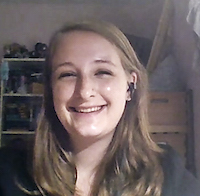
Courtney Johnson
Rowan University
Analyzing proton radiographs of turbulent transport in magnetized HED plasmas
Courtney Johnson, W. Fox, D. Schaeffer, S. Malko
Many laboratory experiments use magnetic fields to control high energy density (HED) plasmas, including studies of inertial fusion energy, magnetized shocks, and magnetic reconnection. Therefore, it is important to understand the coupling and behavior of magnetic fields and HED plasmas – especially turbulent or anomalous transport of plasma relative to the magnetic field. We present experiments at the OMEGA laser facility to study the interaction of a flowing plasma generated from the ablation of a CH target with an external magnetic field powered by MIFEDS. The plasma-field interaction was diagnosed with 2D proton radiography, which measures magnetic fields through the deflections of the protons. A mesh placed between the proton source and plasma served to break the proton beam into quantifiable beamlets. In this work we establish a system for analysis of this data, including algorithms to detect beamlet locations and automatically calculate their deflections from a reference image, which provides information about the evolution of the magnetic field.
Poster
Kayleigh Johnson
University of Arkansas at Pine Bluff
Analyzing proton radiographs of turbulent transport in magnetized HED plasmas
Kayleigh Johnson, Erik Gilson, Maarit Käpylä, Atefeh Barekat
Solar models and helioseismology show that the sun is composed of layers. The layer of the sun comprising the outermost 5% is referred to as the Solar Near Surface Shear Layer, or NSSL and the Convection Zone makes up around 30% of the Sun. Using the Global Convection Simulation, even after implanting the necessary physics, no simulation has been able to successfully reproduce the Coriolis profile of the Sun. The focus of my study is to use a program called Pencil Code to create a simulation that is able to reproduce this profile successfully. Using the Direct Numerical Solution; I directly solve two equations, the momentum equation and the continuity equation. With this approach I am directly in control of my variables, my study varies the parameters: the radius of the Near Surface Shear Layer, the width of the Near Surface Shear Layer, and the forcing strength. To analyze my results, I used the program Pencil Code to import the results of the simulation into the program IDL, this allows for the results to be organized and able to be compared to the known profile of the sun in a suitable manner. Through my study, I will be able to accurately predict the values of the variables that affect the Coriolis profile. This will allow for Other simulation to run successfully and allow greater data of the sun to be discovered by others.
Poster
Carlton Kim
University of California, Irvine
Measuring Electromagnetic Fields in Laboratory Plasmas Using Laser-Wakefield-Accelerated Electrons
Carlton Kim, Will Fox, Derek Schaeffer, Sophia Malko
DParticle radiography is a diagnostic method to obtain crucial information about the magnetic field of plasmas. Radiography involves sending a beam of particles through an electromagnetic field and imaging the resulting deflections of the particles on a detector. Laser-Wakefield-Accelerated (LWFA) electrons may be an accessible, high-energy source for particle radiography diagnostics. Compared to traditional proton radiography, the relativistic speeds associated with the LWFA electrons allow a wider range of magnetic field strengths to be probed. Additionally, LWFA electrons can penetrate thicker material filters and are compatible with high-repetition-rate applications. In this work, electron radiography is studied through synthetic calculations to determine the required energy, fluence, and source size, to properly probe the electromagnetic fields of laboratory plasmas using LWFA electrons.
Poster
Kirstin Koepnick
Bates College
Generating stellarator fields: Using stereographically projected coordinates of S3
K.Koepnick, B. Y. Israeli, C.B. Smiet
A stellarator magnetic field for magnetic confinement fusion is in its essence a divergence free vector field where field lines lie on a folation of nested toroidal flux surfaces where the field lines twist around each other generating rotational transform. We show how to generate a wide class of such fields using the stereographically projected complex coordi- nates on the hypersphere, S3. The configurations included knotted and twisted fields. These fields, originally derived to generate solutions to Maxwells equations, can carry current. We analyze these vector fields for their suitability as stellarator configurations. We show the current configurations of these fields analyze the rotational transforms.
Poster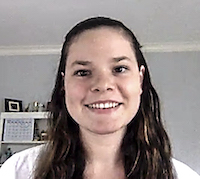
Debra Kranzlin
Fordham University
Implementing the Advanced Annular Couette Centrifuge Method to Optimize Liquid Centrifugation
Debra Kranzlin, Erik Gilson
This theoretical paper aims to determine the effectiveness of implementing the Advanced Annular Couette Centrifuge method into the current types of centrifuges used in the industries around the world. This study identifies specific markets where AACC technology can reduce process times and increase cost-efficiency. This new method can be applied to optimize processes and applications of liquid centrifuges used in industries worldwide. This method’s implementation will be examined through examples in the industries of fruit juices and processing, paints, dyes, and inks, and animal slurry. This research will conclude with where the technology can theoretically be placed in each of the different productions discussed.
Poster
Matthew Lazo
West Virginia University
Langmuir probe data interpretation with a neural network
Matthew Lazo, X. Zhang, F. Poli
Particle diagnostics of tokamak edge plasmas are commonly performed with Lang- muir probes, which are swept at several kHz and produce a large volume of data to be processed for each shot of plasma. Each probe trace is manually truncated and fitted to find corresponding plasma parameters. However, because standard Lang- muir probe characteristics are well-understood for a near-Maxwellian plasma and can be simulated easily as a piecewise function with added noise, an opportunity arises to develop an automated, neural network-based workflow to extract relevant plasma parameters. The NN is trained on simulated Langmuir probe data, then put to work on real data taken from tokamak experiments.
Poster
Alicia Lipperini
Fordham University
Medical applications of plasma activated water and its combination with silver nanoparticles
Alicia Lipperini, Igor Kaganovich, Sierra Jubin
Taking into account previous experimental data and studies regarding plasma activated water, this research deals with plasma-liquid interactions, specifically focusing on plasma activated water and its various uses in medicine, including antiviral applications as well as its utilization as a disinfecting agent. Various studies regarding plasma activated water and its antiviral and disinfecting properties are reviewed and discussed. In addition, the antiviral and antibacterial effects of silver nanoparticles are examined. After exploring the antiviral aspects of both plasma activated water and silver nanoparticles, looking at various studies conducted, the combination of the two and its possible medical applications are discussed. With time and more research conducted regarding the combination of plasma activated water and silver nanoparticles, the use of the two together could possibly provide a more effective and efficient method of antiviral and decontamination treatments.
Poster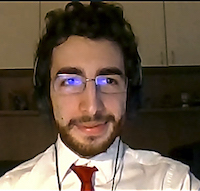
Nicola Lonigro
University of Padua
3D coil design using splines
Nicola Lonigro, Caoxiang Zhu
In recent years many efforts have been undertaken to simplify coil designs for stellarators due to the difficulties in fabricating non-planar coils. The FOCUS code removes the need for a winding surface and represents the coils as arbitrary curves in 3D. In the following work the implementation of a spline representation for the coils in FOCUS is described, along with the implementation of a new engineering constraint to design coils with a straighter outer section. Using splines with the new constraint will allow improved accessibility and simplified maintenance in future reactor designs.
Poster
Elena L. Mitra
City University of New York
Trace Impurity Dynamics in Multi-Species Plasmas
Elena L. Mitra, Nathaniel Fisch, E. J. Kolmes, M. E. Mlodik, I. E. Ochs, T. Rubin
In a mainly two-ion species magnetized plasma, with oppositely directed density gradients maintained by oppositely directed sources of the two species, trace impurity ions are shown to align with the larger mass ion density gradient. This unexpected and curious behavior is derived analytically and simulated numerically using the MITNS (Multiple- Ion Transport Numerical Solver code by E.J. Kolmes, I.E. Ochs and N.J. Fisch [Comput. Phys. Commun.258,107511 (2020)]. The impurity alignment suggests possible applications in plasma mass separation processes and in impurity control in magnetically confined plasma for extracting nuclear fusion energy.
Poster
Matthew Nigh
University of Wisconsin - Platteville
Improved Vertical Stability Model for NSTX-U
Matthew Nigh, Devon Battaglia, Dan Boyer
Establishing stable plasma discharges at large plasma elongation (κ ≥ 2.5) with real-time vertical position con- trol is critical for the mission of the National Spherical Torus Experiment Upgrade (NSTX-U) to realize large nor- malized β (βN > 4) concurrently with large non-inductive current fraction. A database of NSTX-U discharges is uti- lized to establish the maximum controllable open-loop ver- tical instability growth rate realized during operations in 2016. A closed-loop simulation of the real-time vertical po- sition control on NSTX-U was developed to investigate the potential for improvements of the vertical control strategy and to quantify the impact of the poloidal field coil power supplies on the vertical position control near the controller limits. Specifically, the impact of switching transients on the actuators and measurements will be investigated in order to potentially motivate improvements to the power supplies or magnetic measurements.
Poster
Aaditya Rau
Johns Hopkins University
Large Scale Simulations of Plasma Facing Component Boronization
Aaditya Rau, Sierra Jubin, Yuri Barsukov, Stephane Ethier, Igor Kaganovich
Boronization of fusion reactor walls has emerged as a crucial technique in improving the performance of fusion devices and remains a topic requiring further understanding. Previous studies in this area have either made assumptions about the structure of the reactor wall, such as randomized atom placement, or have been limited by simulation size. Thus, in this study, classical molecular dynamics was used to simulate a roughly 1300 atom-large graphite structure undergoing boronization, starting from an ideal graphite crystal. A layered thermostat setup was used to control the reactive dynamics of the boron- graphite interface and bulk crystal. Simulations show the limited adhesion of boron on the graphite surface and the presence of a potential barrier for boron adhesion to graphite, which was confirmed with quantum chemistry calculations. These results are explained, along with observations about the substrate surface temperature and topology.
Poster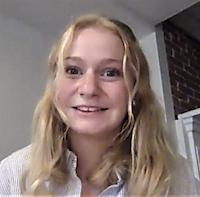
Amelia J. Reilly
Lafayette College
Spectral analysis of edge turbulence in NSTX
Amelia J. Reilly, Stewart J. Zweben
This project focuses on calculating the frequency spectrum of edge turbulence in NSTX. This data came from the gas puff imaging diagnostic which makes a 2-D image of the density fluctuation at the edge. Using this data, a spectrum was calculated using the FFT (Fast Fourier Transform) function in IDL. The result is a broad spectrum from approximately 1 to 70 KHz. This demonstrates the turbulent nature of these fluctuations.
Poster
Maxwell Rosen
NYU
Fast ion orbit modeling using a Chebyshev representation for the magnetic potential
Maxwell Rosen, Leonid Zakharo
Magnetic confinement fusion reactors such as the tokamak are plagued by ion losses which lead to cooling. This work aims to simulate fast ion losses on the Lithium Tokamak Experiment (LTX) and improves on past models by using a Chebyshev approximation for the magnetic potential. This has an advantage over the current bi-cubic spline approximation because the first derivative is continuous using Chebyshev polynomials. A code is written to test the Chebyshev representation in C and CUDA and made to run on a graphical processing unit (GPU).
Poster
Grant Rutherford
Brown University
Modeling Atomic and Molecular Plasma Processes During Startup of PFRC-2
Grant Rutherford, Eugene Evans, Sam Cohen
To study how initial conditions of PFRC-2, a reversed-field configuration device at Princeton, affect startup and the relative importance of different processes during startup, we constructed and solved a 0D model as an initial value problem. Incorporated into the model are hydrogen processes using collisional radiative rate coefficients taken from EIRENE, charged particle loss due to flow parallel to B, enhanced confinement from mirror fields and the FRC, electron interactions with the ends of the machine, and subsequent generation of nonthermal, high energy electrons. By solving the model we obtain electron density and energy as a function of time and can determine the delay to densification. Additionally, we present trends in these outputs as functions of major machine inputs, namely: Pin, nH2 , τe and B.
Poster
Shawn Simko
Coe College
Superconducting coil performance and quench protection
Shawn Simko, Yuhu Zhai
Superconductors transmit current without DC resistance. This permits the development of high field electromagnets for use in accelerators and magnetic confinement fusion devices. However, superconductors have an operational threshold defined by critical temperature, applied magnetic field, and current density. These limits are in part influenced by the radiation environment of the superconductor and the design of the electromagnet coils. Specifically for fusion relevant coils, the neutron radiation produced has been shown to degrade superconductor performance over time, limiting the coil lifespan. The lifetime effects of neutron irradiation can be effectively studied using nuclear fission reactors, specifically those with high flux and a high ratio of fast (>1MeV) to thermal (<.1MeV) neutron flux. Additionally, the use of superconductors without insulation is considered for the improvement of coil stability and protection from resistive transition events. It is found that while some protection is offered, coil stability and charging times are negatively impacted. Finally, some improvements on the no-insulation coil design from literature are considered.
Poster
Matt Slominski
Northwest Missouri State University
Investigation of Variable Radii Crystal Spectrometers for HEDP Applications Through X-Ray Raytracing
M. Slominski, N. Pablant, M. Bitter, K.W. Hill, L. Gao, B.F. Kraus, J. Kring, Y. Yakusevitch
In order to implement newly proposed crystal geometries, a new type of crystal object has been designed for the XICSRT code. This new crystal object features a surface made up of a triangular mesh grid, which allows for more accurate calculation of ray normals on the crystal surface, as well as easier implementation of more complex crystal geometries. Ray tracing results will be provided for a series of mesh-surfaced spherical crystals and validated against results from an identical ray trace run using a generic spherical crystal. These mesh surfaced crystals will vary in mesh-grid density in order to show the effect surface quality has on total throughput and spectral resolution in the detector plane.
Poster
Nathaniel Watkins
University of Pennsylvania
Collisionless Phase Space Equilibria in Plasmas
Nathaniel Watkins, Jason TenBarge, Jimmy Juno, Ammar Hakim
According to Boltzmann’s H-theorem, all collisional processes eventually relax to a Maxwellian particle distribution function, as that particular form maximizes the en- tropy. However, despite the lack of collisions, collisionless plasmas are often observed to be in a quasi-Maxwellian state. This work will determine the universality of equilibrium states in collisionless plasmas by examining the relaxation of the two-stream and Weibel instabilities, through the continuum Vlasov-Maxwell model implemented in the Gkeyll simulation framework. The timescale and final state of the collisionless equilibration will be analyzed.
Poster
Milan A. Wolff
The College of William & Mary
Machine Learning for Shot Classification on the DIII-D Tokamak
M. Wolff, J. Abbate, R. Conlin, E. Kolemen
This research examines preliminary machine learning approaches to classifying shots on the DIII-D tokamak into one of fifteen different modes. The scope of this project encompasses a database of approximately 260 hand-classified experiments on the machine. These experiments contain readily distinguish- able modes, which form the basis for classification using decision trees, output code classifiers, stacking ensembles, and other models. We provide metrics for the accuracy of these different machine learning approaches, with a maximum attained accuracy of approximately 75 percent.
Poster